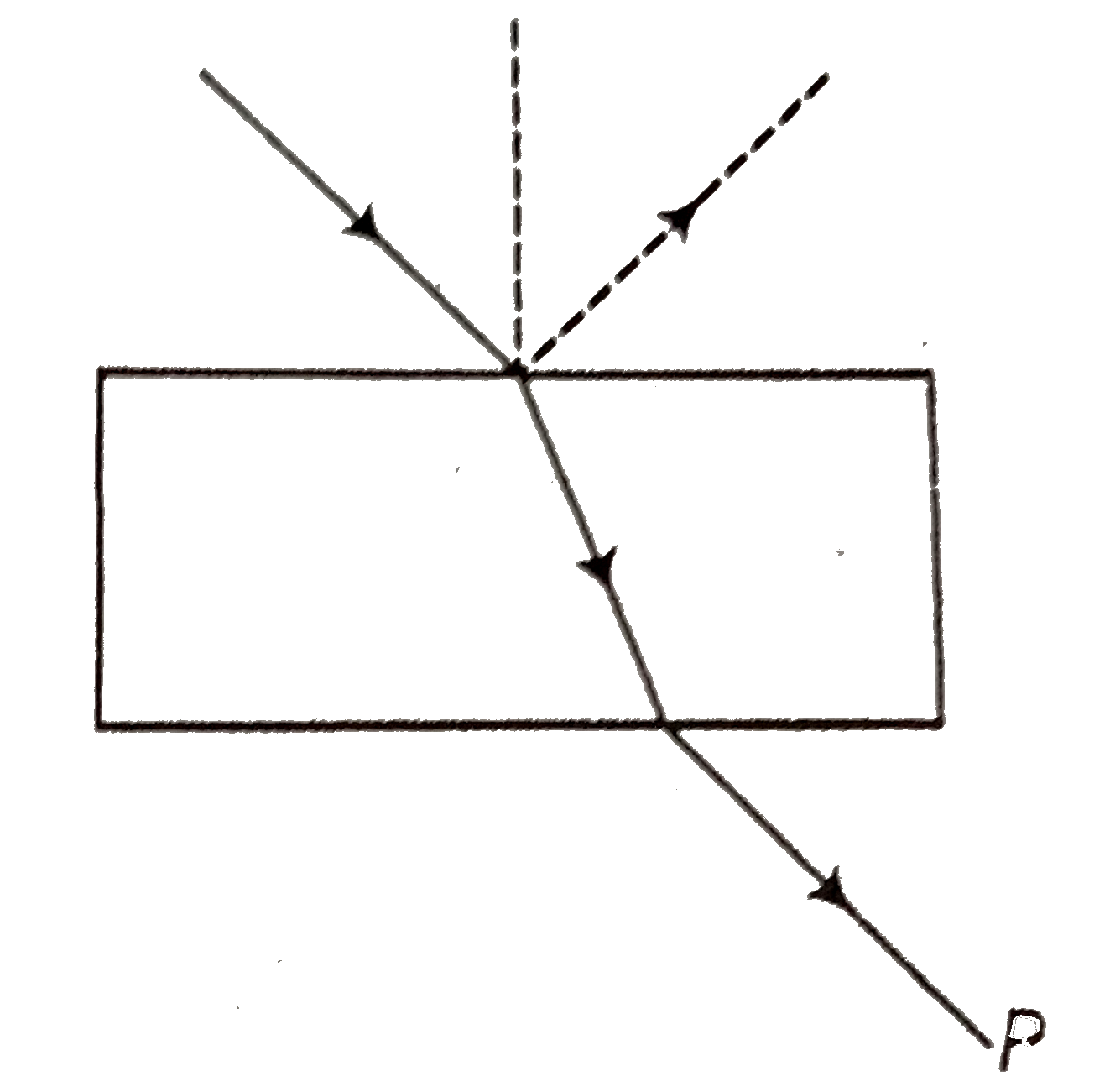When unpolarised light beam is incident from air onto glass () at the polarising angle
reflected beam is polarised 100 percent
reflected and refracted beams are partially polarised
the reason for (1) is that almost all the light is refelcted
all of the above
The correct Answer is:A
To solve the problem of unpolarized light incident from air onto glass at the polarizing angle, we can follow these steps:
Step 1: Understand the Concept of Polarizing Angle
The polarizing angle (also known as Brewster's angle) is the angle of incidence at which light with a particular polarization is perfectly transmitted through a transparent dielectric surface, with no reflection.
Step 2: Use Brewster's Law
Brewster's Law states that the polarizing angle (θ_p) is related to the refractive indices of the two media. The formula is given by:
tan(θp)=n2n1
where n1 is the refractive index of the first medium (air, n1≈1) and n2 is the refractive index of the second medium (glass, n2=1.5).
Step 3: Calculate the Polarizing Angle
Substituting the values into Brewster's Law:
tan(θp)=1.51=1.5
Now, we can find the angle θp:
θp=tan−1(1.5)
Using a calculator, we find:
θp≈56.31∘
Step 4: Conclusion
At the polarizing angle of approximately 56.31∘, the reflected light is completely plane polarized.
Final Answer
The polarizing angle when unpolarized light beam is incident from air onto glass (n=1.5) is approximately 56.31∘.
---
The polarizing angle (also known as Brewster's angle) is the angle of incidence at which light with a particular polarization is perfectly transmitted through a transparent dielectric surface, with no reflection.
Brewster's Law states that the polarizing angle (θ_p) is related to the refractive indices of the two media. The formula is given by:
tan(θp)=n2n1
where n1 is the refractive index of the first medium (air, n1≈1) and n2 is the refractive index of the second medium (glass, n2=1.5).
Substituting the values into Brewster's Law:
tan(θp)=1.51=1.5
Now, we can find the angle θp:
θp=tan−1(1.5)
Using a calculator, we find:
θp≈56.31∘
At the polarizing angle of approximately 56.31∘, the reflected light is completely plane polarized.
The polarizing angle when unpolarized light beam is incident from air onto glass (n=1.5) is approximately 56.31∘.
Topper's Solved these Questions
- RAY OPTICS AND WAVE OPTICS BOOK - VMC MODULES ENGLISHCHAPTER - RAY OPTICS AND WAVE OPTICS EXERCISE - EFFICIENT
49 Videos
- RAY OPTICS AND WAVE OPTICS BOOK - VMC MODULES ENGLISHCHAPTER - RAY OPTICS AND WAVE OPTICS EXERCISE - IMPECCABLE
58 Videos
- RAY OPTICS AND WAVE OPTICS BOOK - VMC MODULES ENGLISHCHAPTER - RAY OPTICS AND WAVE OPTICS EXERCISE - IMPECCABLE
58 Videos
- RAY OPTICS BOOK - VMC MODULES ENGLISHCHAPTER - RAY OPTICS EXERCISE - IN-CHAPTER EXERCISE-J
10 Videos
- REVISION TEST-15 JEE - 2020BOOK - VMC MODULES ENGLISHCHAPTER - REVISION TEST-15 JEE - 2020EXERCISE - PHYSICS
25 Videos
Similar Questions
Ordinary (i.e., unpolarised) lights is incident on the surface of a transparent material at the polarising angle. If it is partly reflected and partly refracted, what is the angle between the reflected and the refracted rays?
View SolutionA ray of ordinary light is travelling in air. It is incident on air glass pair at a polarising angle of 56∘. Find the angle of refraction in glass.
View Solution
Knowledge Check
When a light wave travels from air to glass :
Aits wavelength decreases.Bits wavelength increases.Cthere is no change in wavelength.Dits frequency decreases.
A certain monochromatic light travelling in air is incident on a glass plate at a polarising angle. Angle of refraction in glass is found to be 32∘ Calculate :
(i) the polarising angle,
(ii) refractive index of glass.
View SolutionWhen light is incident from air to glass at an angle 57∘, the reflected beam is completely polarised. If the same beam is incident from water to glass, the angle of incidence at which reflected beam is completely polarised will be
View SolutionAn unpolarised light is incident upon a glass plate of refractive index 1.54 at Brewster's angle and gets completely plane polarised. The angle of polarisation is (given tan 57∘ = 1.54)
View SolutionA : When an unpolarised light is incident on a glass plate at Brewster angle, the reflected ray and refracted ray are matually perpendicular.
R : The refractive index of glass is equal to sine of the angle of polarisation.
View SolutionArrange the intensities of the transmitted light in their increasing order of magnitudes when they are passed through a system of two polarisers
(A) When incident light is unpolarised and of intensity I and the angle between the polarisers is 30∘
(B) When incident light is polarised of intensity 2I and the angle between the polarisers is 45∘
(C ) When polarised light of intensity 4I is incident and the angle between the polarisers is 90∘
(D) When incident light is unpolarised and of intensity 3I and the angle between the polarisers is 30∘
View SolutionConsider a light beam incident from air to a glass slab at Brewster's angle as shown in figure.
A polaroid is placed in the path of the emergent ray at point P and rotated about an axis passing through the centre and pependicular to the plane of the polaroid.

View SolutionConsider a light beam incident from air to a glass slab at Brewster's angle as shown in figure.
A polaroid is placed in the path of the emergent ray at point P and rotated about an axis passing through the centre and pependicular to the plane of the plaroid.

View Solution
